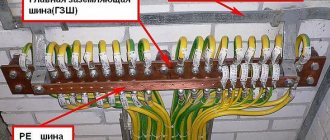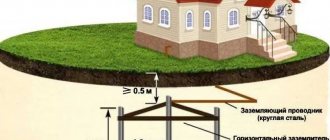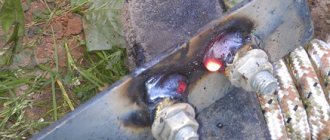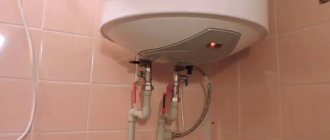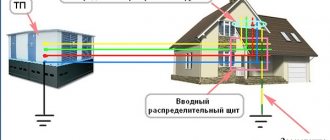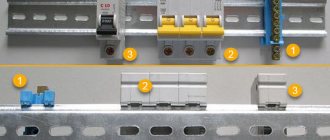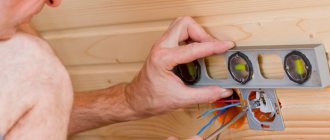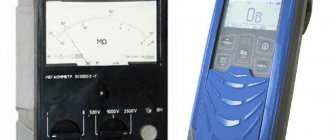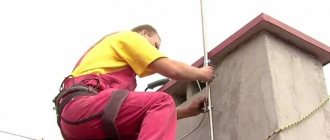In addition, it:
- much more durable
- much easier to install
- and at the same time it is not so expensive (you can find kits for about 5,000 rubles)
Plus to all this, the entire installation is done without welding.
It is the need for welding that stops many people from doing this work themselves. Either there is no apparatus, or there are no necessary skills.
So you have to hire third-party electricians.
All grounding takes up space on the territory of your home, literally a few square centimeters.
And it can be done without any problems right in the basement of the building.
On average, it turns out that in a private house without a boiler, in order to achieve the required 30 Ohms, you will have to drive an electrode with a total length of 6-9 meters. For a house with gas heating (R=10 Ohm) - 9-15 meters.
These are averages. More accurate data is always individual and directly depends on the region where you live, the quality and composition of the soil.
If your house is built on sand, definitely buy a 15-meter kit. Even without a gas boiler.
The distance of the grounding route from the wall is also regulated. Unlike the input cable, it must be at least 1 meter.
For underground cable entry this figure is 0.6 m. Why so, read in detail about these and other requirements in a separate article.
Equipment
What is usually included in the standard kit?
- starting tip
- rods
- couplings
- pin driving head
- attachment for a vibratory hammer or a powerful hammer drill with an SDS-max chuck
- anti-corrosion conductive lubricant
- clamp for connecting the ground wire
- waterproofing tape
Let's take a closer look at each of the points.
Starting pointed tip – which one is better?
It can be with an acute angle of 60 degrees, or a universal angle of 90 degrees. Depends on the density of the soil.
Which angle is better? As a result of scientific research, it was found that the best tip shape is a circular cone.
And the optimal opening (pointing) angle for clay and sandy soils, provided that the strength characteristics are maintained, is from 45 to 53 degrees.
Selection of rods for modular pin grounding
Usually they come copper-plated with a standard length of 1.5 m. For basements with low ceilings, you can take a shorter one - 1.2 m.
The most common rod diameter is 14mm.
They say that the higher the contact patch with the ground, the better. This is certainly true. But don’t expect any super improved resistance characteristics when increasing the cross-section.
According to the formula for calculating grounding for a single vertical ground electrode, the diameter does not greatly affect the overall indicator.
Even if you increase it by 100%, the resistance will decrease by only 9%.
Not what you expected, right? Therefore, there is no particular point in overpaying and buying the thickest possible pins.
Take the minimum allowable according to the standards.
In addition to copper-plated ones, there is another type of threaded rods - couplingless galvanized ones. In them, the rod is simply screwed into one another. On the edge of one pin there is an external thread, on the other - an internal one.
It is impossible to say for sure which is better, copper or zinc. Every manufacturer always praises their products.
However, keep in mind that copper plating, although resistant to corrosion, is only as long as it is not damaged.
And it can be scratched very easily. For example, when using gas wrenches, tightening couplings.
Or when entering rocky soil, knocking off the top layer with the sharp edges of pebbles.
In this case, the copper protective coating is destroyed and the scratch site begins to actively oxidize. Next, there is a gradual but inexorable destruction of the steel core, as a result of which the overall resistance of the entire circuit sharply deteriorates.
That is why the copper coating should be as thick as possible. The recommended value is at least 0.25mm (including thread!).
With zinc the opposite is true. Such pins are not particularly afraid of external damage. In them, zinc is a reducing agent relative to the steel core.
Therefore, here zinc will corrode first, and only then steel. And as long as the entire zinc layer does not deteriorate, the steel core will feel good.
Nevertheless, the warranty periods indicated by manufacturers are approximately as follows:
- copper-plated rods – 30 years
- galvanized – from 20 to 30 years
True, by using galvanization of a larger diameter (20mm > 14mm), the service life indicators can be equalized. However, this does not in any way affect the overall resistance of the grounding conductors. So choose according to your budget.
There are also stainless steel sets.
These are intended for those who do not save at all on electrical costs and want to make a circuit that is called “for centuries.”
Clutchless rods
By the way, despite all the advantages and good contact, many consider threaded connections to be the weakest point of such modular systems.
Think about water pipes lying in the ground. After several years of operation, it is the threaded couplings that rust first.
The same thing can happen with pins. In addition, at the moment of hammering with a vibrating hammer, the connection often weakens. Simply put, the thread is unscrewed.
Experienced installers, after each entry of another rod into the ground, tighten the electrode along the thread. At this point another mistake occurs.
When you tighten a smooth pin or socket with a serrated wrench, you scratch and strip the copper layer from the surface. What this leads to was discussed above.
After 3-4 years, instead of a full-fledged electrode, you will be left with a hollow copper tube with rusty dust inside.
How to do it right? In this case, it is better to pull through the entire system using an impact nozzle inserted into the upper coupling and screwed in until it stops.
This way you will not touch either the electrode or the coupling.
Also note that in all coupling kits, the coupling itself is slightly wider than the diameter of the rod. What does this mean?
A narrower electrode, when entering the ground following such a coupling, will not be in close enough contact with the soil surface. To obtain real resistance indicators, sometimes you have to wait several days until the earth crumbles and compacts all the free spaces.
Therefore, many people prefer a different type of deep grounding rods. For example, like OBO Bettermann with the BP (Bundes Post) system.
In such sets, the pins are joined together without threads, using the pressing method.
This is something like a tongue-and-groove connection with a self-release pin. When driven in, the tenon is tightly wedged into the groove and an absolutely monolithic connection is obtained.
Sometimes inside the hole at the end of one rod there may be a lead ball, which, when struck, fills the entire space even more tightly.
Therefore, if you do not trust couplings and want to eliminate the human factor, buy such kits.
Correct installation of the hammer for driving
Always screw this head all the way in! The design of the coupling and nozzle is such that the nozzle must pass through the coupling until it comes into direct contact with the pin.
This way the impact energy will be transferred to the rod and will not destroy the coupling thread.
If, after screwing in, the thread is visible from the bottom of the coupling, but it is not visible at all on the impact head from above, then you have assembled the kit incorrectly.
In a normal situation, no thread should be visible from below, but 1-2 turns may remain on the driving bolt from above. Otherwise the clutch will jam.
Features of the ground clamp
One part of it is adapted for connecting a pin. The second, under the seat of the wire or grounding bus.
Since the tire is most often made of steel, there is a dividing partition in the middle of the plate. It is necessary to prevent the occurrence of bimetallic corrosion when dissimilar metals come into contact.
How to make modular pin grounding
How is the entire installation done? First, you need to dig a small pit 0.5 m deep.
Next, screw the starting tip onto the first rod.
After that, we try to hammer it into the ground with our hands. To make it easier to enter the ground, add water.
If the ground is soft enough, with forward movements and blows of a small hammer, sometimes it is possible to drive the first pin in completely.
Why is it better to try to do this manually first? When the first or second electrode is clogged, stones often appear in these upper layers. In the case of manual work, the electrode can then be easily pulled out and moved to a new location.
But if you worked with a hammer drill from the very beginning, then the density of its penetration into the ground will be such that without excavating another 1 m it will not be possible to pull it out.
After immersing the first ground electrode, screw on the coupling and insert the second rod.
Don't forget about lubrication. It improves conductive properties and protects threads from corrosion.
Also make sure that the pit is constantly in water. This significantly improves the penetration of the electrodes into the soil.
At the same time, pay attention to an important point! Some unscrupulous electricians try to deceive customers in such a cheap way.
They hammer in two or three electrodes, generously moisten the pit with salted water, sprinkle the area with fresh earth and immediately take a measurement. Indicators with such soil may initially be ideal.
But a few days after the soil dries out, everything changes dramatically. Only you won’t even know about it.
Without special measuring instruments, it is impossible to understand how reliable and high-quality the ground loop is made. You can only cross yourself and believe.
Drive the second and subsequent electrodes into the ground with a high-power impact hammer or jackhammer.
Grounding manufacturers recommend tools with an impact of 20 Joules or higher for this purpose.
That is, it is better that it is not an expensive Hilti hammer drill, but a cheap no-name Chinese hammer.
By the way, there are grounding kits that can be hammered without a jackhammer, but with a regular sledgehammer weighing more than 10 kg.
To do this, you will need a special dowel, on which the blows will be applied.
The most important thing here is not the force of the blow and the size of the swing, otherwise you will quickly break the landing hole, but the uniformity and progression of movements.
When working with punches, pay attention to the curvature of the guide. Due to strong bending and vibration, the impact head often breaks!
After deepening the next pin, a measurement is made. Where black soil and loam with clay predominate, the readings from just one ground electrode can already reach the minimum required 30 ohms. When immersing the second one to a depth of 3m, it is quite possible to approach 10 Ohms.
But where there is sand, the electrodes will simply fly down one by one, without giving the desired result.
The rule here is that the heavier the pin, the better the resistance.
But this of course does not apply to rocky soil.
If almost all the pins from the set have been driven in, and the last one has gone in halfway and stood up as if dead, cut it off with a grinder near the ground, leaving room for compression.
If the resistance results are poor, you will have to retreat a distance equal to the depth of the already clogged ground electrodes and make a second one in a new place. Then connect the two circuits with a horizontal bus.
Ground loop resistance measurements
What should you know about measurements? Keep in mind that if you constantly added water to the pit during installation, all measurements should be repeated the next day, when the soil has dried.
Otherwise, there is a high probability of error.
If you are unable to achieve the standard and all the pins are used up, try pouring an electrically conductive compound for grounding devices into the hole. You dissolve a special powder with water and pour it over the walls of the electrodes into the well.
Fill everything with soil on top and compact the soil. After a day, the composition will tightly clog all the cracks and increase the density of the soil to the ground electrode.
In some cases, it is possible to reduce the resistance by almost half of the original!
Measurements and issuance of a protocol are mandatory! When connecting a house to the power grid, the power engineers of the network company begin to have a lot of questions.
If there are some nuances, they may refuse altogether. And if you have a drawing of a grounding circuit and a measurement protocol, many questions will disappear by themselves.
Therefore, when they say that the grounding loop can be done completely independently with your own hands, they are being a little disingenuous. You will still have to call a third-party organization or an electronic laboratory with measuring instruments.
Previously, the main device for measuring the resistance of the ground loop was M416 and two pins to it.
Today, digital analogues are becoming increasingly popular. For example, such as the IS-10 or the 2120ER meter.
This cannot be done with a regular multimeter!
When checking modular-pin grounding, one peg is driven in at a distance of four times the depth of the ground electrode, the other at two times. On a regular contour (triangle, square, line), the technology is slightly different.
Keep in mind that all measurements are taken in the summer, during the period of maximum drying of the soil.
And now about a mistake that many people are not even aware of.
If the resistance is too good, this is the same “jamb” of installation as too much!
It should be one order of magnitude higher than the grounding resistance at the TP.
There is no need to do it with “reserve” and be happy at the same time. Otherwise, when connected via the TN-CS system, all the “crap”, including short-circuit currents to the ground, will flow primarily not through the transformer substation, but through the grounding of your house!
The current is not a fool, it will tend to where there is less resistance. That is why many, after making an ideal grounding loop, connect their private home using the TT system.
How do you know if everything is in order on the transformer at the energy transmission company? And when was the last time they checked their circuit?
Installation of an inspection well and grounding connection to the outside
When the normalized resistance is reached, a clamp is installed on the last segment to connect the grounding conductor or bus.
This place is protected by an inspection well. This can be either a factory design or a homemade one from a sewer pipe.
Choose those specimens that are designed for use in the ground (orange).
This assembly is a prerequisite for installation. All ground loop contacts must be open and accessible for inspection or replacement.
This place cannot simply be covered with earth. Otherwise, when your grounding wire falls off, you will find out about it only after a serious accident and forced replacement of burnt equipment.
But sometimes it is left directly on the surface without any protection. This is often done in basements. In this case, the grounding is carried out as a solid bus on the wall of the house.
But we will consider the option with a well. Two covers are put on the coupling. A hole is drilled in one of them in the center.
After which a pressure seal or PG seal is mounted there.
These are installed on metal distribution cabinets. Next to it or on the side, another hole is drilled to lead the conductor out into the corrugation.
The central seal is necessary to tightly fit the plug onto the cylindrical grounding pin.
If you do not find similar seals, simply seal all holes after installation with silicone sealant. Next, prepare the copper grounding conductor.
This is PuGV and PV-3 wire with a cross-section of at least 10mm2. It is not advisable to connect it so that the stripped wires stick out.
It is better to do this through pressing with a tip, followed by heat shrinking.
Wrap waterproofing tape over all contacts in compression.
Simple electrical tape will not do here!
After all procedures, the protective coupling is closed on top with a lid.
Do not use a plastic bottle as such protection for the inspection well.
It will never create a seal. Moreover, on the contrary, it will retain water in this place, gradually destroying the contacts.
How to connect the grounding wire and the main grounding bus itself in the panel room of the house, read in a separate article.
Source
Share the news on social networks
- Related Posts
- 5 rules for choosing a good extension cord - wire cross-section and power of devices, how a surge protector protects
- Contactors and starters - explanation of symbols. Technical characteristics of Schneider Electric and IEK.
- Aero-z and aaacz wire - characteristics, comparison with AC, disadvantages and advantages of lines with z wires.
« Previous entry
How to choose the right grounding kit for your home
If you have a problem about organizing grounding for your home or cottage, for a gas boiler or lightning protection, then you may choose a ready-made modular-pin grounding kit. This newest solution will find application both in residential buildings, cottages, and in industrial enterprises and institutions, as it has a considerable range of functionality.
Modular-pin grounding kit
When choosing a grounding kit for your home, there are certain details to consider.
- Type of soil available. It is the characteristics of the soil type that can provide information about its resistivity, which is considered one of the most important nuances in installation work. The resistances of various types of soil can be easily found in the items of a special selection, which is easy to find on the Internet, or in other thematic sources. Resistivity depends on climate and temperature, so it increases significantly in summer.
- The desired resistance to the flow of electric current. It all depends on the facility that will be equipped.
- Depth of groundwater. This directly affects how deep the vertical ground electrode can go. Greater productivity of the process is ensured provided that the material is wetter.
- The number of grounding points that need to be installed. Experienced craftsmen always advise installing the ground electrode to the maximum depth. In some cases, the number of lesions can be increased if difficulties arise with this process.
- Permissible length of horizontal flat conductor. A horizontal conductor is used to connect the grounding electrodes to each other and to the main grounding bus. During the installation process, when using several fireplaces, a certain permissible distance must be maintained between them.
Video - Which grounding system is better
Grounding serves as one of the main safety measures in relation to the electrical network; it contributes to protection from current and the normal operation of all parts of the device system. This process should only be carried out by a master, or at least a person who clearly knows all the nuances of the work. Despite this, everyone should be familiar with the best grounding devices.
We have listed all models of grounding kits in one table in order of increasing quality (but, accordingly, cost):
| № | Name | Length (meters) | Cost (rubles) |
| 13 | LeoGround | 3 | 2600 |
| 12 | ZandZ ZZ-6s | 6 | 8200 |
| 11 | ZANDZ ZZ-6 | 6 | 10800 |
| 10 | ZANDZ ZZ-6t | 6 | 10900 |
| 9 | ZandZ ZZ-000-115 (stainless) | 15 | 23000 |
| 8 | ZandZ ZZ-000-115 | 15 | 25600 |
| 7 | ZandZ ZZ-000-424 | 24 (4 electrodes 6 meters each) | 38200 |
| 6 | ZandZ ZZ-000-130 | 30 | 42400 |
| 5 | ZandZ ZZ-000-030 | 30 | 42500 |
| 4 | GALMAR GL-00030 | 30 | 42600 |
| 3 | ZandZ ZZ-000-636 | 36 (6 electrodes 6 meters each) | 53700 |
| 2 | GALMAR GL-00045 | 45 (15 electrodes 3 meters each) | 69900 |
| 1 | ZandZ ZZ-000-045 | 45 (15 electrodes 3 meters each) | 70000 |
Voting for the best grounding kit for home
Which grounding kit would you choose or recommend?
ZandZ ZZ-000-045
20.00 % ( 1 )
GALMAR GL-00045
0.00 % ( 0 )
ZandZ ZZ-000-636
0.00 % ( 0 )
GALMAR GL-00030
0.00 % ( 0 )
ZandZ ZZ-000-030
0.00 % ( 0 )
ZandZ ZZ-000-130
0.00 % ( 0 )
ZandZ ZZ-000-424
0.00 % ( 0 )
ZandZ ZZ-000-15
0.00 % ( 0 )
ZandZ ZZ-000-115 (stainless)
40.00 % ( 2 )
ZANDZ ZZ-6t
0.00 % ( 0 )
ZANDZ ZZ-6
0.00 % ( 0 )
ZandZ ZZ-6s
20.00 % ( 1 )
Modular grounding systems. Advantages and disadvantages?
Organizm wrote: Well, here again there are two opposing opinions.
My opinion is not the opposite, but adds truthful information about which, out of ignorance or deliberately, manufacturers and sellers are silent. Why are you upset, on the contrary, it’s good that you can learn more fully about the things that interest you and not step on the rake that someone else has already stepped on, especially since you also asked about the shortcomings.
Organizm wrote: Who to listen to
Don’t trust anyone, including me, try to understand for yourself what they write to you about. He is especially attentive to the advice of gurus and people with special education, since they can also make mistakes, and their authority and education can overshadow common sense and the instinct of self-preservation. This also applies to norms that people also write.
Organizm wrote: and what to do?...
If we were doing geology, then it would be clear that it would be advisable to use a deep single modular memory. In any case, the pins only have threaded connections.
In my opinion, connecting pins with a wedge or a pin was done to simplify and save on manufacturing and installation at the expense of reliability. How, instead of connecting connections in distribution boxes by welding, soldering, crimping, and screw clamps, they began to foam at the mouth with flat spring clamps similar to vaginas, as more convenient to install. Yes, flat spring clamps similar to vaginas are comfortable, quickly poke, poke and finish, make a hacky connection.
Organizm wrote: If you split one deep ground electrode into 2 parts of half depth, will this increase the reliability of the structure as a whole?
Yes, the reliability of the memory will increase significantly. Reading your previous questions I wanted to write this, but you thought of it yourself. This, with the correct location of the charger, even if the resistance of the charger becomes less, can better increase the equality of potentials of some conductive parts of the building through the ground that are not included in the SUP, DSUP, which will provide better protective functions of the charger than with a single deep charger.
A deep single charger is justified only when a reconstruction is being done, where there was no charger and there is no space for organizing a ground loop or at least a budget charger, in the form of a segment of a ground loop with at least 3 pins, or an individual charger is needed for the proper functioning of some equipment, and also for a completely wooden house with wooden floors without an underground, basement, or lightning protection.
But in reality, more often a deep single charger is used when they have plowed, remembering about the charger at home when everything around the house has already been improved, and they also sell it to ignorant clients who actually have the opportunity and means to make a grounding loop combined with pins or a budget charger in the form a section of the grounding loop with at least 3 pins, calling the deep single charger with proud, hypnotizing words for the client, grounding, although in fact the deep single charger, according to IEC type A, including in the most stingy version in the form of a casing pipe of a well located in the distance from the house, is not a ground loop, a charger according to IEC type B, providing the best protective functions of an artificial charger!
Organizm wrote: there is an area in front of the entrance to the house 6x4, and city communications run underground here.
When doing landfilling, you need to at least know for sure that there are no communications in the ground. By and large, you need to take permission for excavation work from everyone whose communications may be in the ground.
Organizm wrote: The house has a small basement 2.5x6 deep 2 and I consider this as the priority location for the ground electrode.
By default, artificial charging should be done outside at a distance of 0.8-1 meter from the wall of the building. If possible, try to locate the budgetary storage unit on the side of hazardous premises; perhaps your hazardous premises are not on the side of city communications, in order to at least to some primitive extent equalize the potentials of the conductive parts of the building of hazardous premises that are not included in the control system, emergency control system through the ground, which has already been mentioned higher. We can only say more precisely by location; perhaps the basement would be optimal.
Best Electrolytic Grounding
This type of grounding is widely used for work in permafrost, soil and sandy soils, which have a fairly high resistivity of conductors.
The installation and calculation process itself is not overly difficult. But this method is distinguished by a high level of quality and technical innovations used in the labor process.
Among all products of this type, the ZZ-100-102 grounding kit stands out, since it already contains all the elements necessary for installation work. These components are able to mate freely with each other without effort.
Electrolytic grounding
The best modular-pin grounding
Modular grounding (or model-pin) is a certain type of grounding system, as the name implies. Using it, the builder has the opportunity to change the total length and number of points for organizing vertical ground electrodes in the ground. This type involves a prefabricated structure. It is extremely practical to use it, provided that the condition and characteristics of the soil are subject to frequent changes, and installation conditions are not constant. If you do not want to spend a lot of effort on designing certain boundaries around the perimeter of an object, then this method will pleasantly surprise you with its usefulness and functionality.
Modular-pin grounding
To select the best modular-pin grounding options from a large list, you should pay attention to a number of characteristics and, of course, cost. The price of this product is not as high as many people think. Of course, foreign companies charge higher prices for their goods. As a rule, the price varies between 11,500 – 18,500 rubles. Among all the offers, the most profitable and practical products are MZK-6-R, MZK-6-Z, MZK-6-N, 2GER-6.

